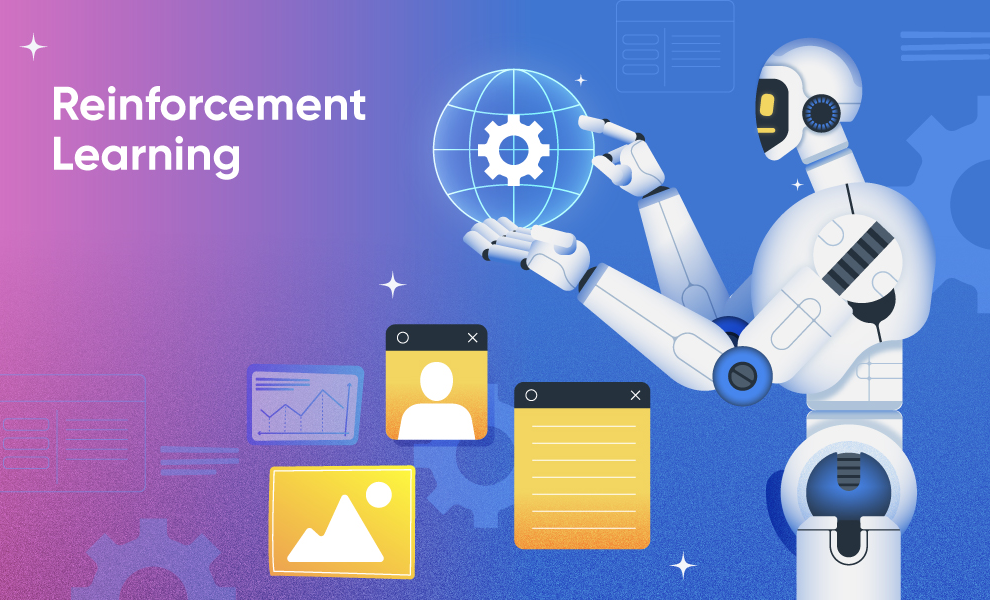Ever wondered how self-driving cars learn to navigate through traffic? The secret is machine learning. Innovations such as AI and ML bear great significance in the fast-growing technological era. However, we seldom discuss the deeper practices of these mechanisms.
Data states that more than 56% of companies worldwide have incorporated ML-powered tactics for business success. Such remarkable integration has been observed across various industries. Companies adopt these technologies in different forms.
In this blog, we shall discuss one of the ML techniques, reinforcement learning (RL), its working, and use cases. Let’s dive in…
What is Reinforcement Learning (RL)?
Reinforcement learning is a machine learning model that continuously trains software and tools to bring the most optimal responses. The mechanism follows a trial-and-error learning process to mimic the human approach while solving a problem. Such methods assist RL in achieving its aim of providing the most appropriate solutions to any query.
Furthermore, RL depends on a reward-and-punishment model while processing data. Therefore, it continuously learns to provide the most convenient output and maximize reward. Reinforcement learning can be advantageous in many ways, including-
Addresses complex tasks: RL is capable of accomplishing complex tasks that can seem challenging to human brains. It depends on different rules and methodologies to process complex data and find effective solutions.
Offers fewer errors: RL utilizes trial-and-error tactics alongside reward-and-punishment. These help eliminate errors in an output to a maximum level. Additionally, this machine learning technique follows a continuous learning process, which allows errors to be fixed effortlessly.
Intends for long-term goals: Reinforcement learning’s primary goal is to offer dependable solutions for longer periods. The chief cause for such an approach is the maximization of rewards. RL intends to achieve its long-term objectives with thorough data processing and analysis.
How does Reinforcement Learning Work?
RL mimics the behavioral psychology process of humans and animals. The RL algorithms follow the reward and punishment methodology that resembles the human tendency to learn. For example, while growing up, human kids may understand that if they do certain tasks, such as helping others and listening to elders, they can receive appreciation from their parents.
On the other hand, if kids do not study attentively and nurture aggressive behavior, they may encounter scolding for it. This method helps children discover which activities can be rewarding for them.
Similarly, reinforcement learning plans and execute different practices to comprehend how to attain rewarding outcomes. In this regard, RL promotes a few key concepts, such as the agent or the ML algorithm, the environment, the action, the state, and the reward. These considerations ultimately assist RL in accomplishing its goal of empowering machines with the ability to provide optimal outcomes.
Use Cases of Reinforcement learning:
Marketing
Personalization is an emerging trend in the contemporary marketing spectrum. RL can assist companies in adopting a personalized approach to customizing offerings according to customer requirements by processing their web interactions.
Gaming:
Reinforcement learning can be significant for the gaming industry. It can enable players to unlock enhanced abilities within games. This can further boost gamers’ user experience, offering them a real-life experience while gaming.
Robotics:
Robots are gradually becoming great human assistants, able to address tasks like humans. RL, in this regard, can help robots attain the capability of learning and implementing insights while executing any task with human-like impact.
Finance:
The financial sector is dynamic yet complex. It majorly depends on solid and reliable predictions. RL processes large amounts of real-time data and identifies patterns to make resilient predictions. This process can remarkably assist the financial domain.
Summing Up!
Reinforcement learning is an emerging ML trend that will likely have a high integration rate in diverse sectors in the upcoming years. Nevertheless, this technology also has certain challenges, such as time and resource consumption, integration complexity, limited applicability, and others. Therefore, it is crucial to consider these difficulties while incorporating RL. Follow our blog updates to never miss an opportunity to attain knowledge.
Also Read:
4 Best Practices for DevSecOps
7 Marketing Automation Trends that are Game-Changers



